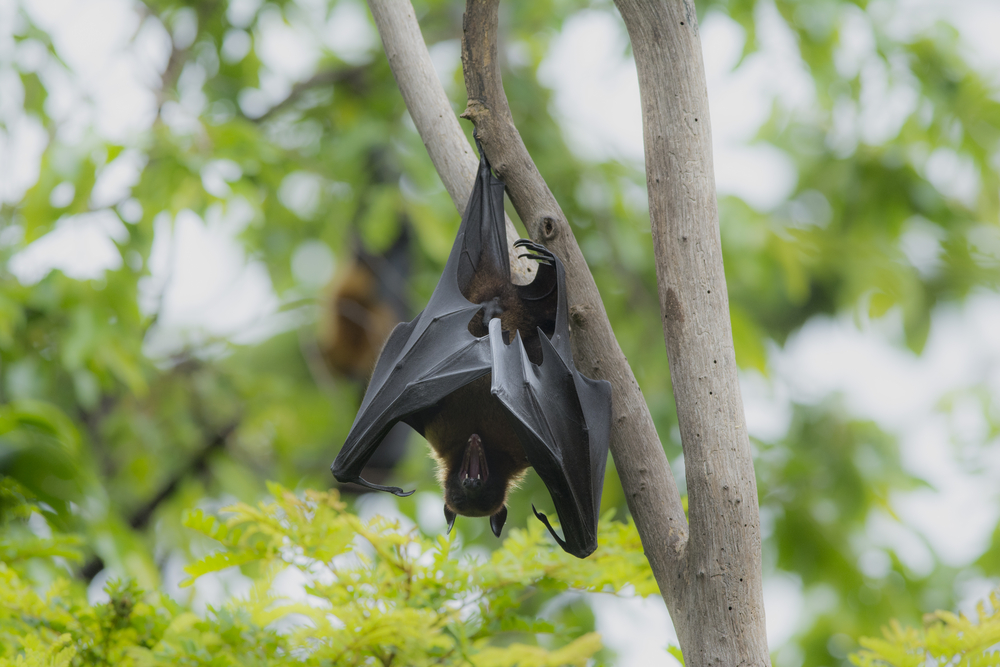Nature’s Spooks, Part 2: Bats
- October 10, 2013
- By Christy Peterson

As I’m writing this, the Halloween candy is already appearing in stores. Along with candy, witches, spiders, and bats are crawling onto the shelves. Last year we talked about spiders. They may make great Halloween decorations, but they really aren’t all that scary. This year, we’ll bust a few myths about bats.
Myth #1: “Blind as a bat.”
There are no blind bats. In fact, bats see very well. However, no animal can see in complete darkness, so many insect-eating bat species rely on echolocation to help them find their prey.
Myth #2: Bats spread rabies.
Any warm-blooded animal can contract rabies, but bats are no more likely to carry rabies than any other animal. They are actually quite tidy, and they certainly don’t waste precious feeding time looking for people to terrorize. You should still use caution if you find a bat on the ground or in your house (or any other wild animal). Please refer to the link below for instructions on helping sick or injured bats.
Myth #3: Bats are pests.
Change one word in that sentence and it will be correct. “Bats EAT pests.” Little brown bats, which are common in much of North America, consume up to 1,000 insects an hour. That’s 1,000 fewer mosquitos per hour per bat! Yes, sometimes bats set up housekeeping in places where they are not wanted, like attics and garages. There a many online resources that suggest ways for discouraging this without harming the animals.
Myth #4: Some bats will suck your blood.
There are three species of vampire bats native to Central and South America that do eat blood. However, they don’t suck blood. Instead, they make a small incision in the “donor” animal and lap up the blood with their tiny tongues. One of these blood-eating bats feeds on blood from mammals (usually livestock). The other two prefer to feed on bird blood. Feeding activities do no cause any harm to the animals, which usually go on sleeping through the entire process.
Bats Are Cool!
Now that we’ve blown away a few myths, let’s talk about how cool bats are. There are about 1,200 species of bats divided two main groups. Megabats are, as the name suggests, larger and primarily fruit-eaters. Microbats are usually smaller and primarily eat insects.
Although people often think of bats as flying rodents, they are not related to rodents at all. They belong to their own group called the Chiroptera, which means “hand-wing.” Genetically they are closer to monkeys than rodents.
The smallest bat is the Kitti’s Hog-nosed bat (AKA bumblebee bat), which weighs about the same as a U.S. penny (2 grams) and has a wingspan of about 6 inches. The largest bats are species of flying foxes, which can have wingspans of up to 6 ½ feet.
In addition to being better bug control that an armada of bug zappers, bats are also important pollinators. Fruit-eating bats are also an important to forest restoration. Their guano, or poop, contains seeds from the fruits they eat. Through the bats, seeds are spread to cut or burned areas, fostering new grow.
Oh, and one more thing—remember last year when we said that spider venom might one day save your life? Well, eventually you may also owe your life to a vampire bat. Researchers have discovered that a chemical in vampire bat saliva breaks up blood clots and may lead to a new treatment for stroke victims. Kind of puts these amazing creatures in a different light, doesn’t it?
Want to Know More?
• Bats4Kids, games, bat house plans, and more: http://www.bats4kids.org/
• “What To Do If You’ve Found a Bat,” from Bat World Sanctuary: http://batworld.org/what-to-do-if-you-found_a_bat/
• Bat Conservation International, includes resources for teachers and kids: http://www.batcon.org/
• The Bat Scientists, by Mary Kay Carson
• 20 Fun Facts About Bats, by Heather Moore Niver
• Hello, Bumblebee Bat, by Darrin Lunde
• Bats, by Gail Gibbons

Kids Discover Talks with Television Lighting Designer Christopher Landy About the Rockefeller Center Christmas Tree Lighting
- December 9, 2025

It’s the Most Wonderful Time of the Year… For Community Service Projects!
- December 8, 2025

The Rockefeller Center Christmas Tree Lights the 2025 Holiday Season in New York City
- December 3, 2025